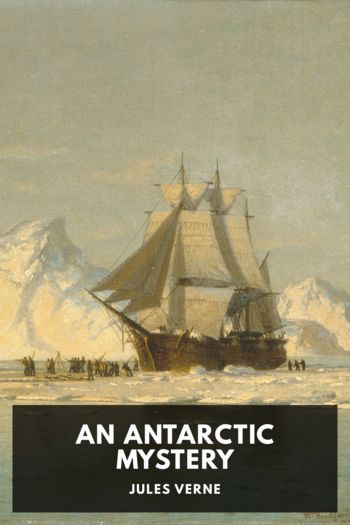Round the Moon by Jules Verne (read aloud txt) 📕

- Author: Jules Verne
Book online «Round the Moon by Jules Verne (read aloud txt) 📕». Author Jules Verne
Yet notwithstanding the perfection of the apparatus, notwithstanding the ingenuity of the savants who were to use them, the success of the operation was anything but assured. Fishing up a bullet from 20,000 feet under water must be an uncertain operation. And even if the bullet should again be brought to the surface, how had the travellers borne the terrible shock that even 20,000 feet of water would not sufficiently deaden?
In short, everything must be done quickly. J. T. Maston hurried on his workmen day and night. He was ready either to buckle on the diver’s dress or to try the air-apparatus in order to find his courageous friends.
Still, notwithstanding the diligence with which the different machines were got ready, notwithstanding the considerable sums which were placed at the disposition of the Gun Club by the Government of the Union, five long days (five centuries) went by before the preparations were completed. During that time public opinion was excited to the highest point. Telegrams were incessantly exchanged all over the world through the electric wires and cables. The saving of Barbicane, Nicholl, and Michel Ardan became an international business. All the nations that had subscribed to the enterprise of the Gun Club were equally interested in the safety of the travellers.
At last the grappling-chains, air-chambers, and automatic grappling-irons were embarked on board the Susquehanna. J. T. Maston, the engineer Murchison, and the Gun Club delegates already occupied their cabins. There was nothing to do but to start.
On the 21st of December, at 8 p.m., the corvette set sail on a calm sea with a rather cold northeast wind blowing. All the population of San Francisco crowded on to the quays, mute and anxious, reserving its hurrahs for the return.
The steam was put on to its maximum of tension, and the screw of the Susquehanna carried it rapidly out of the bay.
It would be useless to relate the conversations on board amongst the officers, sailors, and passengers. All these men had but one thought. Their hearts all beat with the same emotion. What were Barbicane and his companions doing whilst they were hastening to their succour? What had become of them? Had they been able to attempt some audacious manoeuvre to recover their liberty? No one could say. The truth is that any attempt would have failed. Sunk to nearly two leagues under the ocean, their metal prison would defy any effort of its prisoners.
On the 23rd of December, at 8 a.m., after a rapid passage, the Susquehanna ought to be on the scene of the disaster. They were obliged to wait till twelve o’clock to take their exact bearings. The buoy fastened on to the sounding-line had not yet been seen.
At noon Captain Blomsberry, helped by his officers, who controlled the observation, made his point in presence of the delegates of the Gun Club. That was an anxious moment. The Susquehanna was found to be at some minutes west of the very spot where the projectile had disappeared under the waves.
The direction of the corvette was therefore given in view of reaching the precise spot.
At 12:47 p.m. the buoy was sighted. It was in perfect order, and did not seem to have drifted far.
“At last!” exclaimed J. T. Maston.
“Shall we begin?” asked Captain Blomsberry.
“Without losing a second,” answered J. T. Maston.
Every precaution was taken to keep the corvette perfectly motionless.
Before trying to grapple the projectile, the engineer, Murchison, wished to find out its exact position on the sea-bottom. The submarine apparatus destined for this search received their provision of air. The handling of these engines is not without danger, for at 20,000 feet below the surface of the water and under such great pressure they are exposed to ruptures the consequences of which would be terrible.
J. T. Maston, the commander’s brother, and the engineer Murchison, without a thought of these dangers, took their places in the air-chambers. The commander, on his footbridge, presided over the operation, ready to stop or haul in his chains at the least signal. The screw had been taken off, and all the force of the machines upon the windlass would soon have brought up the apparatus on board.
The descent began at 1:25 p.m., and the chamber, dragged down by its reservoirs filled with water, disappeared under the surface of the ocean.
The emotion of the officers and sailors on board was now divided between the prisoners in the projectile and the prisoners of the submarine apparatus. These latter forgot themselves, and, glued to the panes of the port-lights, they attentively observed the liquid masses they were passing through.
The descent was rapid. At 2:17 p.m. J. T. Maston and his companions had reached the bottom of the Pacific; but they saw nothing except the arid desert which neither marine flora nor fauna any longer animated. By the light of their lamps, furnished with powerful reflectors, they could observe the dark layers of water in a rather large radius, but the projectile remained invisible in their eyes.
The impatience of these bold divers could hardly be described. Their apparatus being in electric communication with the corvette, they made a signal agreed upon, and the Susquehanna carried their chamber over a mile of space at one yard from the soil.
They thus explored all the submarine plain, deceived at every instant by optical delusions which cut them to the heart. Here a rock, there a swelling of the ground, looked to them like the much-sought-for projectile; then they would soon find out their error and despair again.
“Where are they? Where can they be?” cried J. T. Maston.
And the poor man called aloud to Nicholl, Barbicane, and Michel Ardan, as if his unfortunate friends could have heard him through that impenetrable medium!
The search went on under those conditions until the vitiated state of the air in the apparatus





Comments (0)